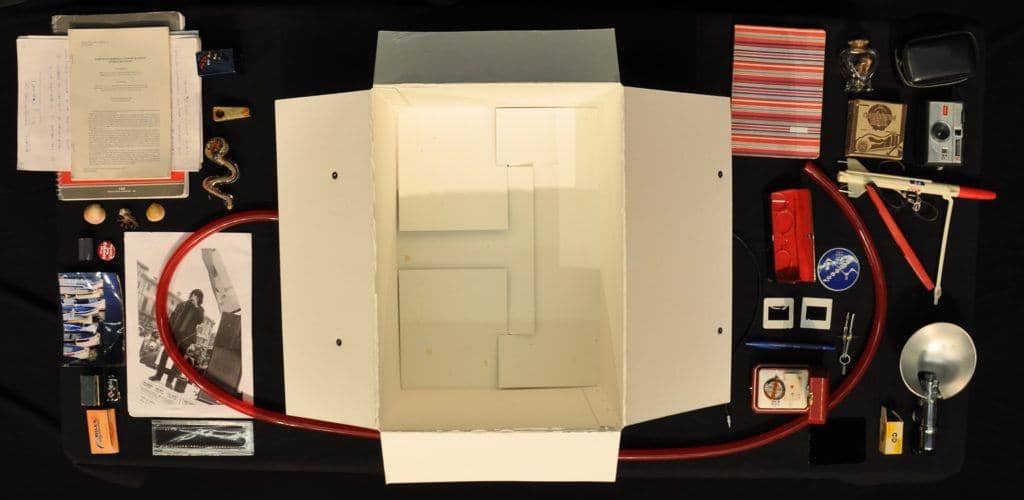The red tubing extends about six feet, the words “Sideral 12x18 Antigelo – Italy” stamped in white at intervals along its length.
It coils amid a jumble of photos, papers, and objects. A multi-coloured glass pipe. Three seashells. An Instamatic camera still holding a roll of film. They are disparate pieces of an unwritten story. Carlo Rovelli’s story.
“My worst defect is the difficulty of distancing myself from the past, so these items were precious to me,” wrote Rovelli, one of the founders of loop quantum gravity. “Please handle them with care. Each is a piece of my years and my heart.”
That note was written to Krista Blake, the curator who sent empty archive boxes to dozens of people in order to create Archive Fever, a hands-on art exhibit that was featured in Perimeter’s George Leibbrandt Library in February 2015.
The boxes and a corresponding list of contributors aren’t cross-referenced. Guests don white gloves, and then grope for meaning among seemingly unrelated fragments of life.
For Blake, the process is intricately linked to science: archaeologists construct meaning from the remnants of societies; physicists craft theories from pieces of evidence.
“These throwaway items, you can assemble them and get a really clear picture of what life is like,” Blake says. “You don’t know what the objects were, but you know they had meaning.”
Objects are also impartial, Rovelli says. They are impervious to the simplification and re-arrangements of memory. Of all the items packed in his box – the pins, the toy, the scientific papers – that red tube is, for him, the most precious.
“It is the tube I used for stealing gasoline from parked cars, in the night, when I was a kid, so I could drive across Europe more or less for free. I used to leave a little ‘Sorry, thanks’ note.”
Carlo Rovelli's Archive Fever box, fully unpacked.[/caption]
The contents of Carlo Rovelli's box in Archive Fever:
- Draft science papers
- Loop Space Representation of Quantum General Relativity, the scientific paper that “made my career”
- Science notes and calculations
- Music box
- Marble pipe
- Multi-coloured glass pipe
- Two shells and coral
- Roll of film
- "I'm loopy for Carlo" pin
- Photocopied photo prints: speaking at a peace rally; herding a goat named Lucrezia
- Various photographs
- “Errha” photography self-timer
- Rizla Original rolling paper
- Kodak Gold negatives
- Cable
- Black glass plate, marked "Athermal DIN A 777", used to see his first eclipse
- Cartier box containing: Scuola Italiana Sci Livrio pin; Club Di Topolino pin (the Mickey Mouse Club); Red star-and-sickle pin; peace sign pin; small ace of hearts
- Adox Tessina film
- Camera flash reflector
- Blue pen
- Compass
- Projector slides
- Eyeglasses (broken)
- Veronesi Sci Club sticker
- Rocket toy, made by Quercetti
- Kodak Instamatic 50 (with film)
- Prop from the set of a film about Russian physicist Lev Landau
- Glass heart bottle containing flower and petals
- 6' of red tube, used to siphon gas from parked cars
- Three notebooks of calculations
https://www.youtube.com/watch?v=d-cK2XeCMWk
About PI
Perimeter Institute is the world’s largest research hub devoted to theoretical physics. The independent Institute was founded in 1999 to foster breakthroughs in the fundamental understanding of our universe, from the smallest particles to the entire cosmos. Research at Perimeter is motivated by the understanding that fundamental science advances human knowledge and catalyzes innovation, and that today’s theoretical physics is tomorrow’s technology. Located in the Region of Waterloo, the not-for-profit Institute is a unique public-private endeavour, including the Governments of Ontario and Canada, that enables cutting-edge research, trains the next generation of scientific pioneers, and shares the power of physics through award-winning educational outreach and public engagement.
You might be interested in



